Abstract
Vacuum UV circular dichroism (CD) spectra were measured down to 175 nm for d(C)10, d(G)10, the d(G)10.d(C)10 duplex, and the d(G)10.d(G)10.d(C)10 triplex. A CD difference spectrum was calculated for d(G)10.d(C)10 giving the change in CD induced by forming the duplex from d(G)10 and d(C)10. The d(G)10.d(G)10.d(C)10 CD difference spectrum gave the CD induced by triplex formation from binding of d(G)10 to the d(G)10.d(C)10 duplex. In the near-UV, the d(G)10.d(C)10 and d(G)10.d(G)10.d(C)10 difference spectra resembled the difference spectrum for poly[r(G).r(C)] (Biopolymers 29, 325-333). This similarity may be an indication of similar purine base stacking. The d(G)10.d(G)10.d(C)10 vacuum UV difference spectrum had a negative band at 195 nm and a positive band at 180 nm, making it similar to difference spectra for homopolymer triplexes containing T.A.T and U.A.U triplets (Nucl. Acids Res. 19, 2275-2280). The appearance of these bands in difference spectra should be good indicators of triplex formation. The complementary oligonucleotides c-mycI d(CCCCACCCTCCC) and c-mycII d(GGGAGGGTGGGG) are part of the regulatory sequences of the human c-myc gene. G.G.C rich triplexes formed by binding c-mycII or c-mycIII d(GGGGTGGGTGGG) to the c-mycI.c-mycII duplex had CD difference spectra similar to that of d(G)10.d(G)10.d(C)10 in both the vacuum UV and near UV regions, indicating similar triplet structures.
Full text
PDF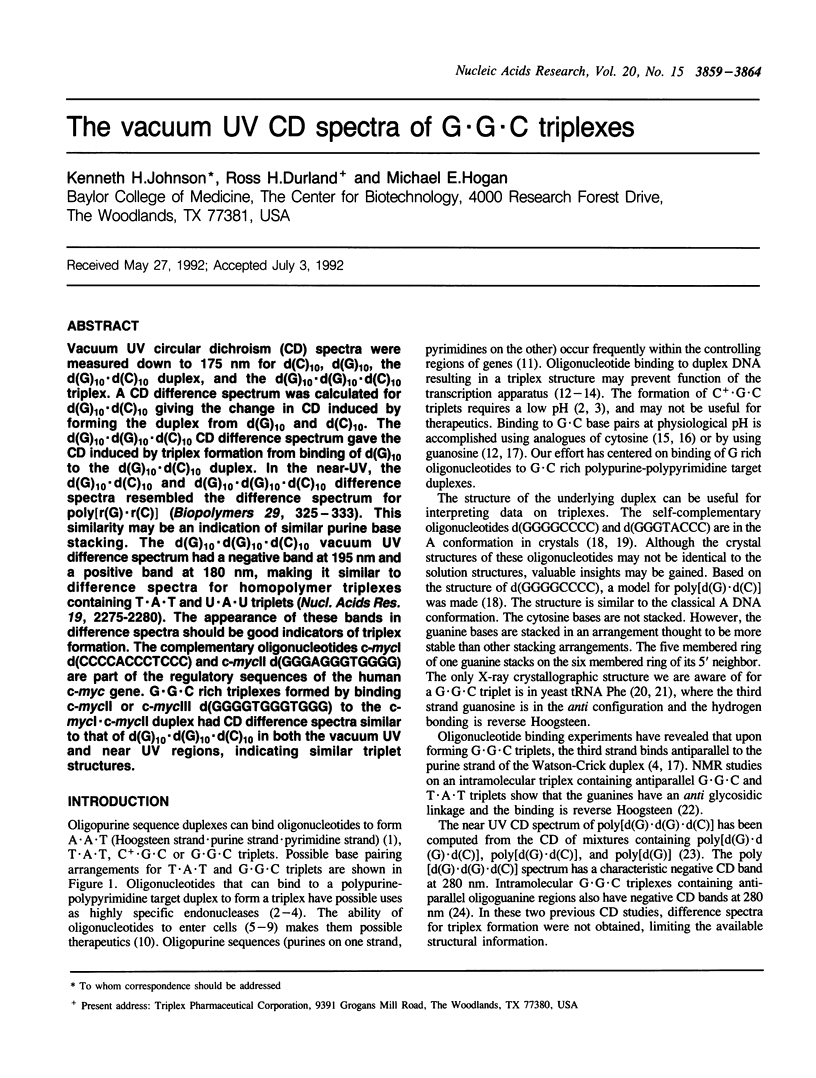
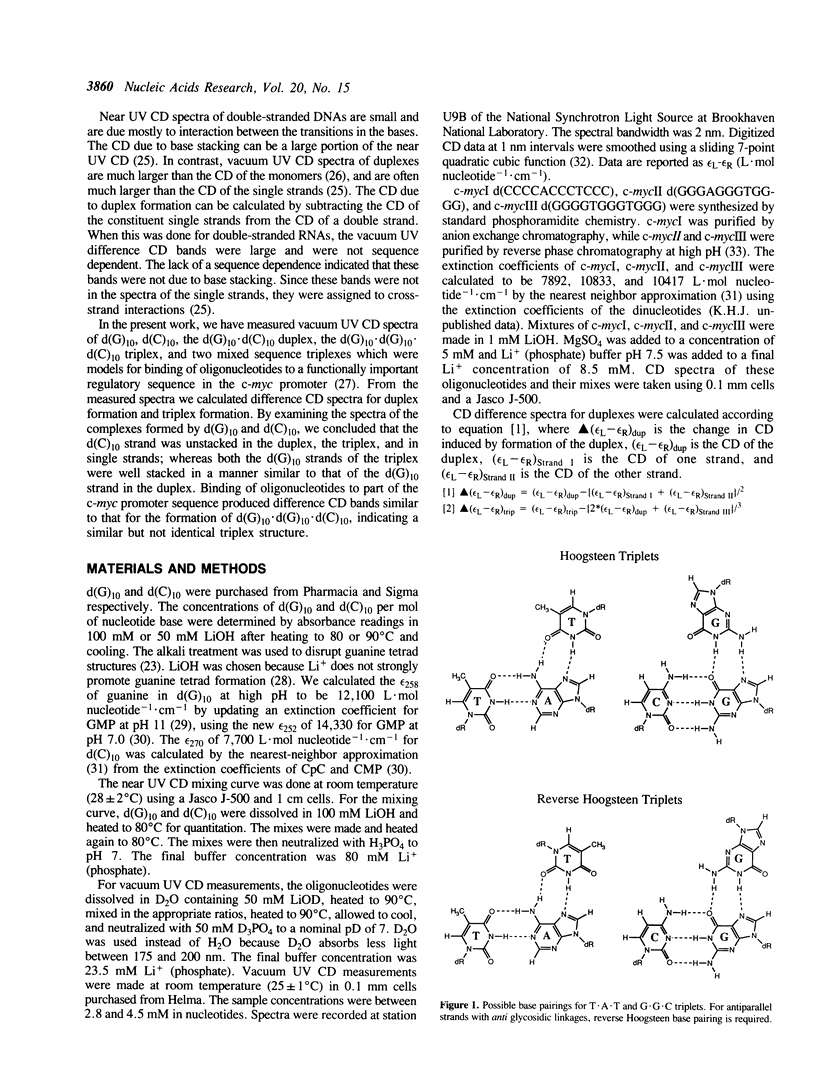
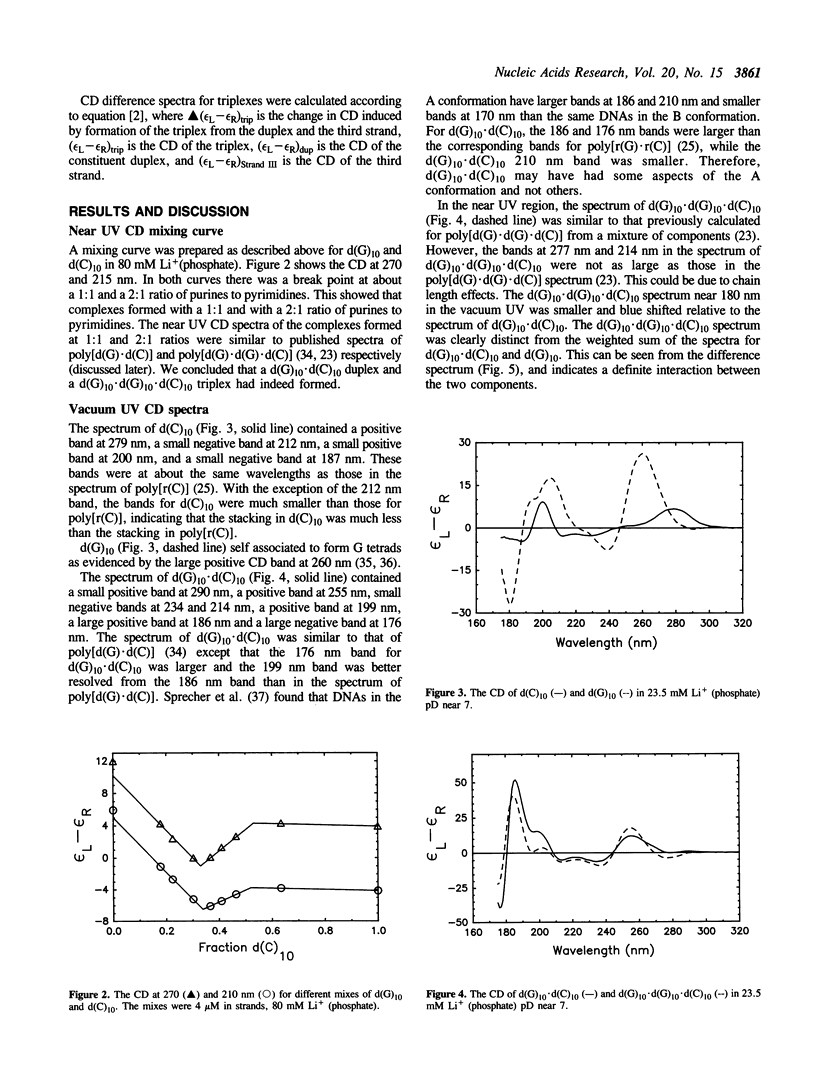
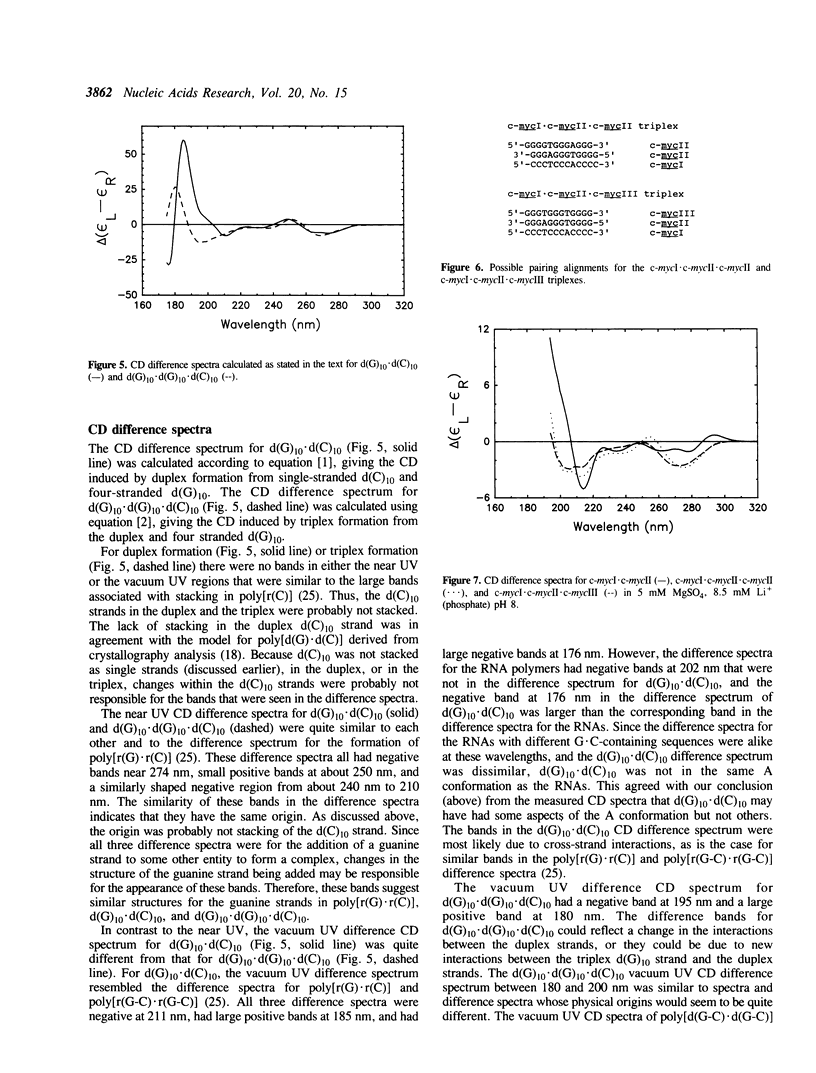
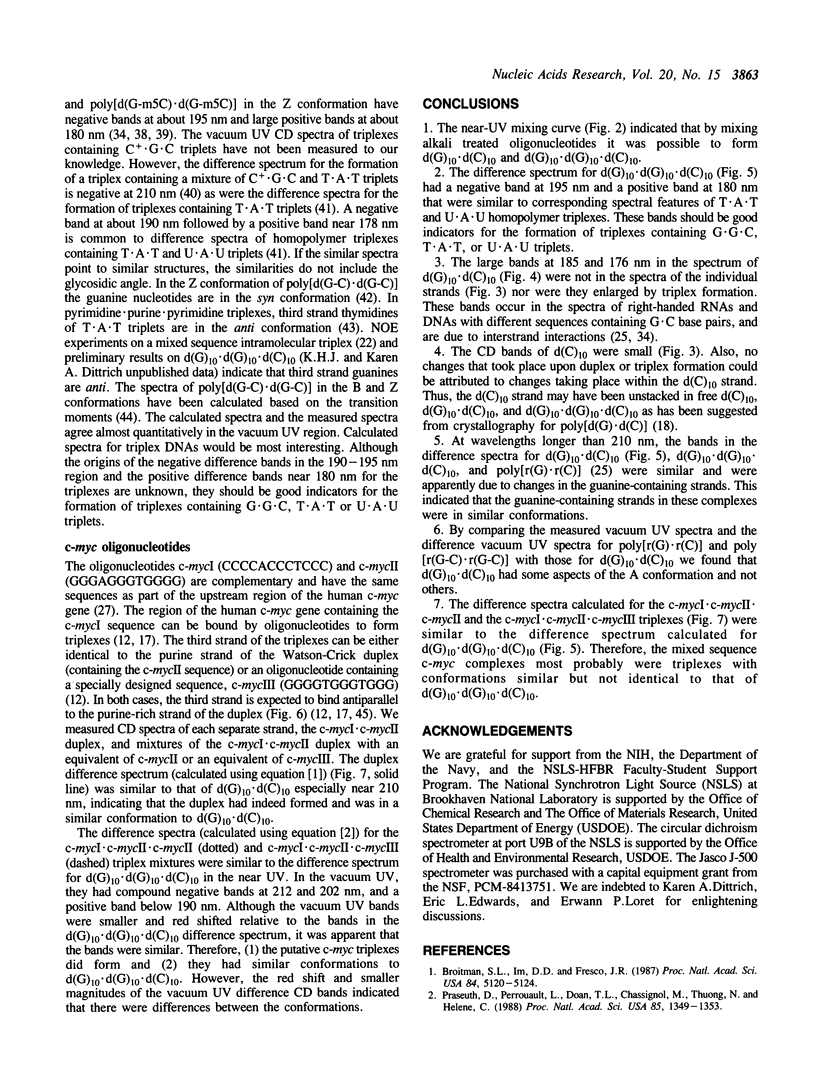
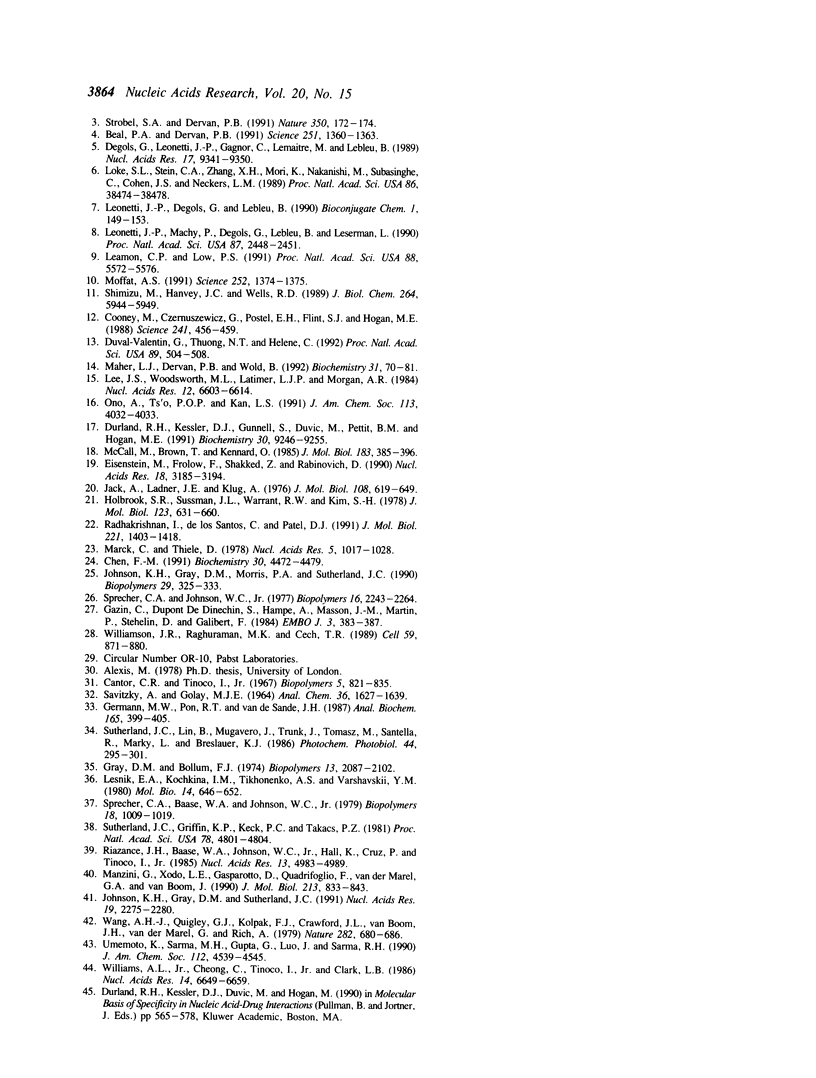
Selected References
These references are in PubMed. This may not be the complete list of references from this article.
- Beal P. A., Dervan P. B. Second structural motif for recognition of DNA by oligonucleotide-directed triple-helix formation. Science. 1991 Mar 15;251(4999):1360–1363. doi: 10.1126/science.2003222. [DOI] [PubMed] [Google Scholar]
- Broitman S. L., Im D. D., Fresco J. R. Formation of the triple-stranded polynucleotide helix, poly(A.A.U). Proc Natl Acad Sci U S A. 1987 Aug;84(15):5120–5124. doi: 10.1073/pnas.84.15.5120. [DOI] [PMC free article] [PubMed] [Google Scholar]
- Cantor C. R., Tinoco I., Jr Calculated optical properties of 64 trinucleoside diphosphates. Biopolymers. 1967;5(9):821–835. doi: 10.1002/bip.1967.360050905. [DOI] [PubMed] [Google Scholar]
- Chen F. M. Intramolecular triplex formation of the purine.purine.pyrimidine type. Biochemistry. 1991 May 7;30(18):4472–4479. doi: 10.1021/bi00232a014. [DOI] [PubMed] [Google Scholar]
- Cooney M., Czernuszewicz G., Postel E. H., Flint S. J., Hogan M. E. Site-specific oligonucleotide binding represses transcription of the human c-myc gene in vitro. Science. 1988 Jul 22;241(4864):456–459. doi: 10.1126/science.3293213. [DOI] [PubMed] [Google Scholar]
- Degols G., Leonetti J. P., Gagnor C., Lemaitre M., Lebleu B. Antiviral activity and possible mechanisms of action of oligonucleotides-poly(L-lysine) conjugates targeted to vesicular stomatitis virus mRNA and genomic RNA. Nucleic Acids Res. 1989 Nov 25;17(22):9341–9350. doi: 10.1093/nar/17.22.9341. [DOI] [PMC free article] [PubMed] [Google Scholar]
- Durland R. H., Kessler D. J., Gunnell S., Duvic M., Pettitt B. M., Hogan M. E. Binding of triple helix forming oligonucleotides to sites in gene promoters. Biochemistry. 1991 Sep 24;30(38):9246–9255. doi: 10.1021/bi00102a017. [DOI] [PubMed] [Google Scholar]
- Duval-Valentin G., Thuong N. T., Hélène C. Specific inhibition of transcription by triple helix-forming oligonucleotides. Proc Natl Acad Sci U S A. 1992 Jan 15;89(2):504–508. doi: 10.1073/pnas.89.2.504. [DOI] [PMC free article] [PubMed] [Google Scholar]
- Eisenstein M., Frolow F., Shakked Z., Rabinovich D. The structure and hydration of the A-DNA fragment d(GGGTACCC) at room temperature and low temperature. Nucleic Acids Res. 1990 Jun 11;18(11):3185–3194. doi: 10.1093/nar/18.11.3185. [DOI] [PMC free article] [PubMed] [Google Scholar]
- Gazin C., Dupont de Dinechin S., Hampe A., Masson J. M., Martin P., Stehelin D., Galibert F. Nucleotide sequence of the human c-myc locus: provocative open reading frame within the first exon. EMBO J. 1984 Feb;3(2):383–387. doi: 10.1002/j.1460-2075.1984.tb01816.x. [DOI] [PMC free article] [PubMed] [Google Scholar]
- Germann M. W., Pon R. T., van de Sande J. H. A general method for the purification of synthetic oligodeoxyribonucleotides containing strong secondary structure by reversed-phase high-performance liquid chromatography on PRP-1 resin. Anal Biochem. 1987 Sep;165(2):399–405. doi: 10.1016/0003-2697(87)90288-0. [DOI] [PubMed] [Google Scholar]
- Gray D. M. A circular dichroism study of poly dG, poly dC, and poly dG:dC. Biopolymers. 1974;13(10):2087–2102. doi: 10.1002/bip.1974.360131011. [DOI] [PubMed] [Google Scholar]
- Holbrook S. R., Sussman J. L., Warrant R. W., Kim S. H. Crystal structure of yeast phenylalanine transfer RNA. II. Structural features and functional implications. J Mol Biol. 1978 Aug 25;123(4):631–660. doi: 10.1016/0022-2836(78)90210-3. [DOI] [PubMed] [Google Scholar]
- Jack A., Ladner J. E., Klug A. Crystallographic refinement of yeast phenylalanine transfer RNA at 2-5A resolution. J Mol Biol. 1976 Dec 25;108(4):619–649. doi: 10.1016/s0022-2836(76)80109-x. [DOI] [PubMed] [Google Scholar]
- Johnson K. H., Gray D. M., Morris P. A., Sutherland J. C. A.U and G.C base pairs in synthetic RNAS have characteristic vacuum UV CD bands. Biopolymers. 1990 Feb 5;29(2):325–333. doi: 10.1002/bip.360290205. [DOI] [PubMed] [Google Scholar]
- Johnson K. H., Gray D. M., Sutherland J. C. Vacuum UV CD spectra of homopolymer duplexes and triplexes containing A.T or A.U base pairs. Nucleic Acids Res. 1991 May 11;19(9):2275–2280. doi: 10.1093/nar/19.9.2275. [DOI] [PMC free article] [PubMed] [Google Scholar]
- Leamon C. P., Low P. S. Delivery of macromolecules into living cells: a method that exploits folate receptor endocytosis. Proc Natl Acad Sci U S A. 1991 Jul 1;88(13):5572–5576. doi: 10.1073/pnas.88.13.5572. [DOI] [PMC free article] [PubMed] [Google Scholar]
- Lee J. S., Woodsworth M. L., Latimer L. J., Morgan A. R. Poly(pyrimidine) . poly(purine) synthetic DNAs containing 5-methylcytosine form stable triplexes at neutral pH. Nucleic Acids Res. 1984 Aug 24;12(16):6603–6614. doi: 10.1093/nar/12.16.6603. [DOI] [PMC free article] [PubMed] [Google Scholar]
- Leonetti J. P., Degols G., Lebleu B. Biological activity of oligonucleotide-poly(L-lysine) conjugates: mechanism of cell uptake. Bioconjug Chem. 1990 Mar-Apr;1(2):149–153. doi: 10.1021/bc00002a010. [DOI] [PubMed] [Google Scholar]
- Leonetti J. P., Machy P., Degols G., Lebleu B., Leserman L. Antibody-targeted liposomes containing oligodeoxyribonucleotides complementary to viral RNA selectively inhibit viral replication. Proc Natl Acad Sci U S A. 1990 Apr;87(7):2448–2451. doi: 10.1073/pnas.87.7.2448. [DOI] [PMC free article] [PubMed] [Google Scholar]
- Maher L. J., 3rd, Dervan P. B., Wold B. Analysis of promoter-specific repression by triple-helical DNA complexes in a eukaryotic cell-free transcription system. Biochemistry. 1992 Jan 14;31(1):70–81. doi: 10.1021/bi00116a012. [DOI] [PubMed] [Google Scholar]
- Manzini G., Xodo L. E., Gasparotto D., Quadrifoglio F., van der Marel G. A., van Boom J. H. Triple helix formation by oligopurine-oligopyrimidine DNA fragments. Electrophoretic and thermodynamic behavior. J Mol Biol. 1990 Jun 20;213(4):833–843. doi: 10.1016/S0022-2836(05)80267-0. [DOI] [PubMed] [Google Scholar]
- Marck C., Thiele D. Poly(dG).poly(dC) at neutral and alkaline pH: the formation of triple stranded poly(dG).poly(dG).poly(dC). Nucleic Acids Res. 1978 Mar;5(3):1017–1028. doi: 10.1093/nar/5.3.1017. [DOI] [PMC free article] [PubMed] [Google Scholar]
- McCall M., Brown T., Kennard O. The crystal structure of d(G-G-G-G-C-C-C-C). A model for poly(dG).poly(dC). J Mol Biol. 1985 Jun 5;183(3):385–396. doi: 10.1016/0022-2836(85)90009-9. [DOI] [PubMed] [Google Scholar]
- Moffat A. S. Triplex DNA finally comes of age. Science. 1991 Jun 7;252(5011):1374–1375. doi: 10.1126/science.2047850. [DOI] [PubMed] [Google Scholar]
- Praseuth D., Perrouault L., Le Doan T., Chassignol M., Thuong N., Hélène C. Sequence-specific binding and photocrosslinking of alpha and beta oligodeoxynucleotides to the major groove of DNA via triple-helix formation. Proc Natl Acad Sci U S A. 1988 Mar;85(5):1349–1353. doi: 10.1073/pnas.85.5.1349. [DOI] [PMC free article] [PubMed] [Google Scholar]
- Radhakrishnan I., de los Santos C., Patel D. J. Nuclear magnetic resonance structural studies of intramolecular purine.purine.pyrimidine DNA triplexes in solution. Base triple pairing alignments and strand direction. J Mol Biol. 1991 Oct 20;221(4):1403–1418. [PubMed] [Google Scholar]
- Riazance J. H., Baase W. A., Johnson W. C., Jr, Hall K., Cruz P., Tinoco I., Jr Evidence for Z-form RNA by vacuum UV circular dichroism. Nucleic Acids Res. 1985 Jul 11;13(13):4983–4989. doi: 10.1093/nar/13.13.4983. [DOI] [PMC free article] [PubMed] [Google Scholar]
- Shimizu M., Hanvey J. C., Wells R. D. Intramolecular DNA triplexes in supercoiled plasmids. I. Effect of loop size on formation and stability. J Biol Chem. 1989 Apr 5;264(10):5944–5949. [PubMed] [Google Scholar]
- Sprecher C. A., Baase W. A., Johnson W. C., Jr Conformation and circular dichroism of DNA. Biopolymers. 1979 Apr;18(4):1009–1019. doi: 10.1002/bip.1979.360180418. [DOI] [PubMed] [Google Scholar]
- Sprecher C. A., Johnson W. C., Jr Circular dichroism of the nucleic acid monomers. Biopolymers. 1977 Oct;16(10):2243–2264. doi: 10.1002/bip.1977.360161012. [DOI] [PubMed] [Google Scholar]
- Strobel S. A., Dervan P. B. Single-site enzymatic cleavage of yeast genomic DNA mediated by triple helix formation. Nature. 1991 Mar 14;350(6314):172–174. doi: 10.1038/350172a0. [DOI] [PubMed] [Google Scholar]
- Sutherland J. C., Griffin K. P., Keck P. C., Takacs P. Z. Z-DNA: vacuum ultraviolet circular dichroism. Proc Natl Acad Sci U S A. 1981 Aug;78(8):4801–4804. doi: 10.1073/pnas.78.8.4801. [DOI] [PMC free article] [PubMed] [Google Scholar]
- Sutherland J. C., Lin B. H., Mugavero J., Trunk J., Tomasz M., Santella R., Marky L., Breslauer K. J. Vacuum ultraviolet circular dichroism of double stranded nucleic acids. Photochem Photobiol. 1986 Sep;44(3):295–301. doi: 10.1111/j.1751-1097.1986.tb04667.x. [DOI] [PubMed] [Google Scholar]
- Wang A. H., Quigley G. J., Kolpak F. J., Crawford J. L., van Boom J. H., van der Marel G., Rich A. Molecular structure of a left-handed double helical DNA fragment at atomic resolution. Nature. 1979 Dec 13;282(5740):680–686. doi: 10.1038/282680a0. [DOI] [PubMed] [Google Scholar]
- Williams A. L., Jr, Cheong C., Tinoco I., Jr, Clark L. B. Vacuum ultraviolet circular dichroism as an indicator of helical handedness in nucleic acids. Nucleic Acids Res. 1986 Aug 26;14(16):6649–6659. doi: 10.1093/nar/14.16.6649. [DOI] [PMC free article] [PubMed] [Google Scholar]
- Williamson J. R., Raghuraman M. K., Cech T. R. Monovalent cation-induced structure of telomeric DNA: the G-quartet model. Cell. 1989 Dec 1;59(5):871–880. doi: 10.1016/0092-8674(89)90610-7. [DOI] [PubMed] [Google Scholar]


